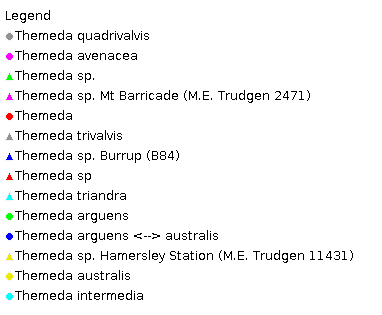Themeda Fl. Aegypt.-Arab. 178 (1775).
Derivation:. From the Arabic thaemed (little water), possibly referring to water storage cells on the upper surface of the leaves or to the habitat of the type specimen in Yemen, fide L.K.A.Chippindall and A.O.Crook, Grasses of Southern Africa (1976).
Taxonomic revisions, nomenclatural references:. S.T.Blake, Proc. Roy. Soc. Queensland 80: 81–82 (1969); B.K.Simon, Aust. Syst. Bot. Soc. Newsletter 43: 15–17 (1985).
Key references (keys and floras):. C.A.Gardner, Flora of Western Australia 1 Gramineae 342–345 (1952); J.W.Vickery, Flora of New South Wales, Gramineae 19: 59–63 (1961); E.E.Henty, Manual Grasses New Guinea 184–185 (1969); M.Lazarides, Tropical Grasses S.E. Asia 76–78 (1980); M.Lazarides, Flora of Central Australia 493–494 (1981); J.C.Tothill and J.B.Hacker, Grasses of Southern Queensland 402–404 (1983); J.P.Jessop, Flora of South Australia 4: 1993–1994 (1986); B.K.Simon, Flora of the Kimberley Region 1227 (1992); B.K.Simon, Key to Australian Grasses 169 (1993); S.W.L.Jacobs and C.A.Wall, Flora of New South Wales 4: 447–448 (1993); N.G.Walsh, Flora of Victoria 2: 626–627 (1994); D.I.Morris, Student's Flora of Tasmania 4B: 357–358 (1994); E.Edgar and H.E.Connor, Flora of New Zealand 5: 611–613 (2000); D.Sharp and B.K.Simon, AusGrass (2002); J.P.Jessop, Grasses of South Australia 533–534 (2006); S.W.L.Jacobs, R.D.B.Whalley & D.J.B.Wheeler, Grasses of New South Wales, 4th ed, 382–384 (2008).
W.D.Clayton & S.A.Renvoize, Genera Graminum (1986), genus (622).
Native and naturalised. 18 species, from Old World Tropics. 5 species in Australia, WA, NT, SA, Qld, NSW, Vic, and Tas. Also New Guinea, Malesia and New Zealand.
Habit. Annual or perennial, tufted (coarse, very rarely stoloniferous). Leaf blades narrow. Ligule an unfringed membrane to a fringed membrane.
Inflorescence. Inflorescence paniculate (leafy, comprising short racemes in spatheate, hard-to-interpret clusters), a spatheathe panicle, open, spatheate, terminal branches contracted into tight heads, a compound pseudo-inflorescence (composed of short racemes in spatheate clusters: each cluster terminated by 1–3 pairs of spikelets, one of each pair sessile and bisexual, the other pedicelled and male or sterile (or a triplet of 1 terminal sessile spikelet with 2 pedicellate ones), the whole surrounded by a whorl of 4 male or sterile, sessile spikelets constituting an involucre). Spikelet-bearing axes much reduced, with heteromorphic spikelets, clustered (the racemes solitary in their spatheoles, these units in groups of three or more in short capituliform glomerules), disarticulating at joints (each raceme disarticulating at the level of the female-fertile spikelets).
Spikelets. Spikelets subterete to dorsally compressed, 2 flowered, with 1 fertile floret, associated with bractiform involucres (constituted by the four imperfect spikelets), paired and in triplets, sessile and pedicelled, in pedicelled/sessile combinations; sessile spikelet with lower incomplete floret. Fertile spikelets falling with glumes (the clusters disarticulating immediately above the involucres).
Glumes. Glumes more or less equal, long relative to adjacent lemmas, awnless, with keel conspicuously winged or without a median keel-wing, leathery. Lower glume convex on back, relatively smooth, 7–11 nerved. Upper glume 1–5 nerved.
Florets. Lower incomplete floret(s) sterile. Lemmas awnless, 0 nerved, similar in texture to fertile lemmas (hyaline), not becoming indurated. Fertile florets 1. Lemmas hyaline, stipitate beneath the awn, less firm than glumes, not becoming indurated, usually entire at apex, awned, 1 nerved, glabrous. Awns 1, usually apical, geniculate, hairy, much shorter than body of lemma to much longer than body of lemma. Palea present or absent, when present conspicuous and relatively short or very reduced, nerveless. Callus pointed. Lodicules 2. Stamens 3. Grain small, longitudinally grooved (channelled down one side), compressed dorsiventrally. Hilum short. Embryo large. Pedicels free of rachis. Pedicelled spikelets present, different from sessile spikelet, male.
Kranz Anatomy. C4.
2n = 20, 40, 60, and 80 (and aneuploids), commonly adventive.
Habitat. Mesophytic. Savanna. Species of open habitats.
Classification. Panicoideae; Andropogoneae.
Notes. The genus is clearly related to Heteropogon though the nature of the inflorescence is not always easy to perceive as the racemes are much modified and often compacted into dense clusters. The sessile spikelet is normally shed in the usual way, but in two species the whole raceme is deciduous with the sessile spikelets still attached. Themeda is distinguished from Iseilema by the homogamous pairs being separated by a short internode (Clayton and Renvoize, 1986).
Types Species. T. triandra Forssk.
Biogeographic Element. Clifford & Simon 1981, Simon & Jacobs 1990: Old World Tropics.


